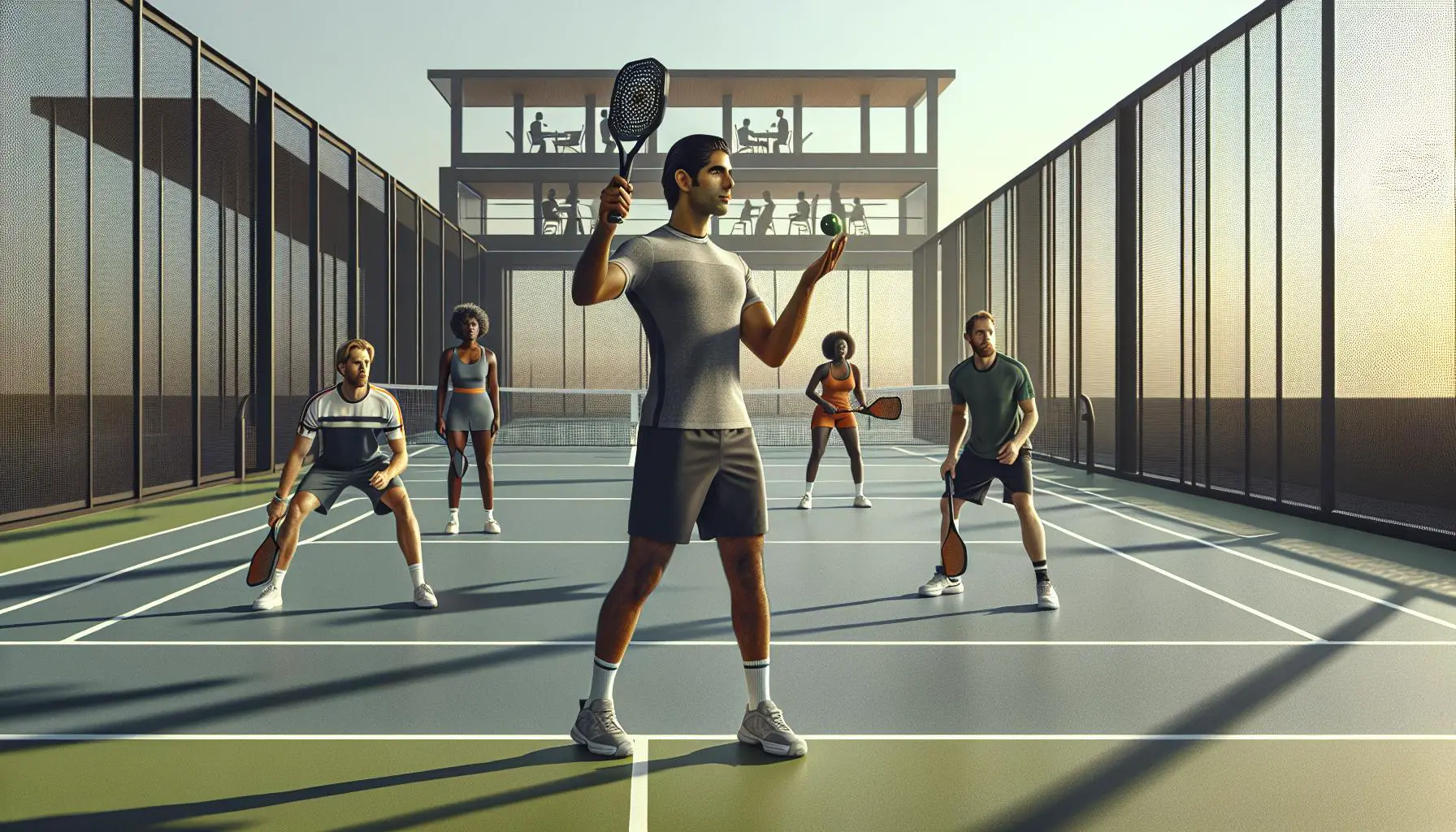Pickleball’s surge in popularity isn’t just a fluke; it’s a testament to the game’s infectious appeal and accessibility. But before you dive headfirst into this paddle sport sensation, getting to grips with the basics, like court dimensions and line rules, is crucial. They’re the backbone of fair play and the key to understanding the game’s flow.
The court, a blend of tennis and badminton dimensions, offers a unique playing field that’s both approachable for beginners and challenging for seasoned players. Meanwhile, the line rules might seem daunting at first, but they’re what make pickleball uniquely strategic and engaging. Let’s break down these fundamentals to get you court-ready in no time.
Overview of Pickleball Court Dimensions
Pickleball, a sport that has taken the world by storm, features a unique set of court dimensions that are integral to its play. Designed to offer a perfect blend of strategy and physicality, the court is smaller than a tennis court, yet larger than a badminton court, making it accessible for players of all ages and skill levels.
The Basics of Court Size
The official dimensions of a pickleball court are 20 feet in width by 44 feet in length. This size is uniform for both singles and doubles play, ensuring that players do not have to adjust to different sizes for different modes of play. The compact size facilitates quicker reflexes and longer rallies, making the game both challenging and engaging.
Key Areas of the Court
The pickleball court is divided into several key areas, each with its own rules and purposes:
- Non-volley zone: Also known as the “kitchen,” this area extends 7 feet from the net on both sides. Players are not allowed to volley (hit the ball before it bounces) when standing in this zone, adding a strategic layer to the game.
- Service areas: On either side of the non-volley zone, there are two service squares on each side of the court, measuring 15 feet in length. This is where players must serve into during a game.
- Baseline and sidelines: These mark the outer boundaries of the court. The ball must stay within these lines during play, or else it is considered out of bounds.
Court Markings
To help players navigate the court, clear lines mark the different zones. These lines are typically 2 inches in width, ensuring they are visible during fast-paced play. The centerline extends from the non-volley line to the baseline, dividing the service areas into left and right sides. This helps servers determine where they should be standing during play.
Pickleball’s growing popularity owes much to its inclusive and straightforward design. Understanding the dimensions and layout of the court is the first step towards mastering the game. With its easy-to-learn, hard-to-master dynamics, the sport attracts a diverse range of enthusiasts, from beginners looking for a fun recreational activity to competitive players seeking strategic depth and physical challenges.
Key Line Rules in Pickleball

In pickleball, understanding the key line rules is as crucial as knowing the court dimensions. These rules ensure fair play and add an extra layer of strategy to the game.
The Serve
When serving, the ball must land in the diagonal service box across the net and past the non-volley zone, also known as the kitchen. If the ball touches any part of the non-volley zone line on the serve, it’s considered a fault. This rule encourages precision and control, making the serve a critical component of strategy in pickleball.
The Non-Volley Zone
The non-volley zone, extending 7 feet from the net on both sides, has specific rules to maintain the game’s fast pace. Players cannot volley (hit the ball before it bounces) from within this zone. The rule prevents players from dominating the net and ensures a dynamic and engaging rally. Importantly, if a player’s momentum carries them into the non-volley zone after a volley shot, it’s considered a fault.
The Baseline and Sidelines
The boundaries of the court are defined by the baseline and sidelines. In pickleball, a ball is considered in if it lands on any part of these lines, except during the serve, where the non-volley zone lines come into play. This rule simplifies line calls and encourages players to use the entire court.
The Double Bounce Rule
A unique feature of pickleball is the double bounce rule. After the serve, the ball must bounce once before the receiving team can return it, and likewise, the serving team must let the ball bounce before returning. This rule slows down the initial exchange, allowing players of all skill levels to engage in strategic play.
Kitchen Line Faults
Being mindful of the kitchen or non-volley zone lines is essential. Players cannot touch these lines when volleying the ball. This includes the player’s feet, paddles, or any part of their clothing. Also, a player cannot step on the kitchen line when volleying a shot that bounces in the kitchen.
These fundamental lines and rules shape the game, making pickleball accessible yet strategically complex. Whether you’re a beginner or seasoned player, mastering these aspects will significantly enhance your game.
Differences Between Pickleball Court and Tennis/Badminton Court

Pickleball courts may look similar to tennis and badminton courts at a glance, but they boast unique dimensions and layouts that distinguish them. For those transitioning from tennis or badminton to pickleball, understanding these differences is key to mastering the game.
Court Dimensions
First and foremost, the dimensions of a pickleball court are 20 feet wide by 44 feet long for both singles and doubles play. This contrasts sharply with tennis courts, which measure 27 feet wide for singles and 36 feet wide for doubles, with a length of 78 feet. Badminton courts, on the other hand, are quite similar in length to pickleball courts at 44 feet but are narrower at 17 feet wide for singles and 20 feet wide for doubles.
| Sport | Width (Feet) | Length (Feet) |
|---|---|---|
| Pickleball | 20 | 44 |
| Tennis | 27 (Singles) / 36 (Doubles) | 78 |
| Badminton | 17 (Singles) / 20 (Doubles) | 44 |
Net Height
The net height is another vital difference. In pickleball, the net is hung at 36 inches on the sidelines and dips to 34 inches in the middle. Tennis nets stand at a uniform height of 36 inches across the entire width. Badminton opts for a higher net, at 60 inches, significantly altering the style of play and strategies used.
| Sport | Net Height (Inches) |
|---|---|
| Pickleball | 36 (Sides) / 34 (Middle) |
| Tennis | 36 |
| Badminton | 60 |
Importance of Understanding Pickleball Court Dimensions and Line Rules

For anyone looking to dive into the world of pickleball, grasping the importance of court dimensions and line rules isn’t just beneficial—it’s a game changer. This knowledge not only sets the foundation for mastering the sport but also for enjoying it to its fullest. Pickleball, with its unique blend of elements from tennis, badminton, and ping-pong, requires a distinct approach, and understanding the layout of the court is where it all begins.
Pickleball courts are smaller than those used in tennis, which means players need to cover less ground. This could imply a more straightforward game, but in reality, the reduced size demands precise shot placement and a strategic mindset. The net, sitting at a height of 34 inches in the center, further emphasizes the need for skillful arcs and angles in shots. Unlike tennis or badminton, where power and speed might dominate, pickleball rewards finesse and thoughtfulness.
The court is divided into zones: two service areas and a non-volley zone, commonly called “the kitchen.” The non-volley zone extends 7 feet from the net on both sides, a unique feature to pickleball. This area prohibits players from executing a volley, meaning they can’t hit the ball before it bounces. This rule is designed to reduce the advantage of net play and encourage longer rallies. Knowing precisely where you can and cannot volley from is crucial, as stepping into the kitchen to volley is a common way players lose points.
Line rules in pickleball also have their quirks. The ball is considered in if any part of it touches any of the line markings on the court. Therefore, understanding the exact boundaries becomes critical during fast-paced exchanges. Players often find that their perception of the court’s dimensions can significantly influence their strategic approach to both defending and attacking.
Moreover, serving in pickleball comes with its own set of guidelines that are tightly linked to the court’s layout. The serve must be done underhand, and the ball needs to land within the opposite diagonal service area. This rule emphasizes the importance of precision and control over power. A good serve in pickleball isn’t just about getting the ball in play; it’s about placing it strategically to put the opponent at a disadvantage right from the start.
Conclusion
Grasping the essentials of pickleball court dimensions and line rules isn’t just about playing by the book. It’s about leveraging every inch of the court to your advantage, turning strategic thinking and precise shot placement into your most powerful assets. With these insights, players can step onto the court with confidence, ready to serve with precision and navigate the game’s unique features skillfully. Remember, in pickleball, it’s not just the strongest who thrive, but the most strategic. So, lace up your sneakers, grab your paddle, and get ready to master the court with finesse and control.














0 Comments